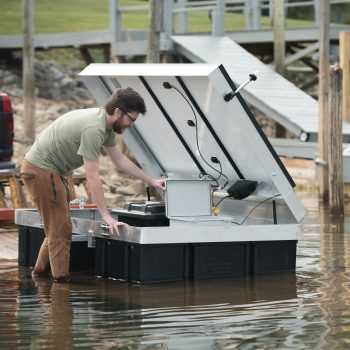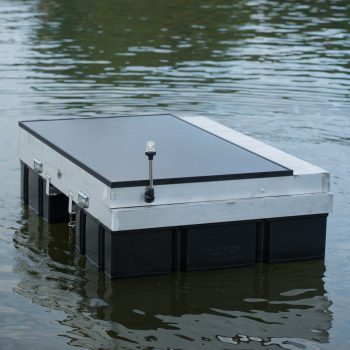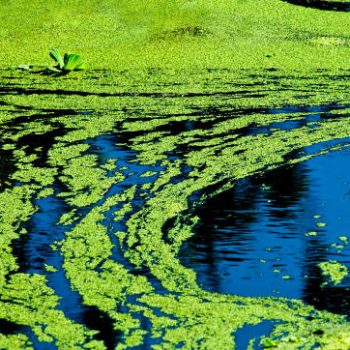Get started on controlling algae blooms and biofilm in your water
To choose the best solution for your algae or biofilm problems, it’s important to understand how these challenging water conditions arise and how they work. We’ve made it a little easier for you.
What is algae? What is biofilm? A simple introduction.
Learn the basics about algae and biofilm, natural organisms in bodies of water all over the world.
Though not as varied as fingerprints, algae are a diverse group of aquatic organisms that (with up to a million estimated species) come in a vast range of shapes and sizes. Most people have encountered at least some of the more common varieties, such as seaweed, pond scum or the algal blooms that blanket the surface of lakes. Like land plants, algae use photosynthesis to generate energy, requiring only water, sunlight, carbon and nutrients, like nitrogen and phosphorus to thrive. Algae can play an important role in a balanced water environment, acting as food for some tiny animals and generating oxygen for larger ones.
Biofilm, the bacterial cousin of algae, is a layer of microorganisms which forms on surfaces in contact with water, such as rocks in ponds and lakes, boats and piers in marinas, equipment in water reservoirs and treatment facilities. These dense colonies of bacteria can cause any number of problems: decreasing water quality, generating bad tastes and smells, and serving as food for invasive species, such as zebra mussels. These tiny mollusks band together to clog pipes, render beaches unusable, and destroy boat engines.
What are the problems with algae and biofilm?
When algae and biofilm spin out of control, they can seriously impact water quality, safety, health, and our water treatment infrastructure.
More than just an unsightly scourge, harmful algae blooms result in costly maintenance and damage to our water systems, including ponds, lakes and lagoons, water treatment facilities, swimming pools, industrial tanks and cooling towers. The proliferation of harmful algae blooms (HAB) threatens our quality of life and access to clean and safe water, resulting in:
- Dangerous levels of water toxicity ingested by people, pets, fish and livestock
- Violation of regulated wastewater treatment discharge limits (including pH and % of suspended solids)
- Increased water treatment operating costs for clarification filtration, taste, and odor treatment, creating budgetary problems for municipalities and other entities
- Negative impacts to property values and tourism
Similar to algae, an excess of biofilm and creates a number of challenges for operators, the public, and the environment, including:
- Increased risk of toxic algae in recreational water, harmful to people, pets and other animals
- The onset of a new generation of carcinogenic chlorinated by-products resulting in new regulations and fines
- Invasive species such as zebra mussels, barnacles, and oysters that attach to surfaces and can clog pumping and piping infrastructure and pumping operations
- Increased operating costs due to heat exchange fouling and loss of cooling efficiency
- Costly damage to boats, including under deposit corrosion in piping and surfaces; boat hull fouling which increases drag and drives up fuel costs
- Resulting in manganese precipitation (which causes a color change to water) can cause harmful health effects
Across the globe, our water resources are under attack from the pervasive spread of algal blooms and biofilm. An increased use of fertilizers, nutrient pollution and warmer water temperatures create an environment for these problems to continue to thrive.
Learn how ultrasound technology controls algae and biofilm
Ultrasonic technology from WaterIQ Technologies™ leverages science and sustainability to put an end to out-of-control algae and biofilm growth. This technology is helping return water ecosystems to their natural state using a sonic alternative to harmful chemicals. Ultrasound waves disrupt algae cells, causing them to lose buoyancy, sink and die—all without harming other aquatic life. The ultrasonic waves also create what is perceived as turbulence by the microorganisms that comprise biofilm, causing them to avoid colonization on treated surfaces and become a food source for invasive species such as zebra mussels.
WaterIQ Technologies™ products and solutions control algae and biofilm safely, efficiently, and in an environmentally friendly way – without the use of dangerous chemicals.
Learn how our ultrasound technology works to control algae and biofilm problems, and meet the product solutions we offer to treat your application.
Not all ultrasound technology is equally effective. You should look carefully at the features of an ultrasonic product to select the best system for your algae or biofilm challenges. To start, learn more about the WaterIQ Technologies™ advancements and next generation ultrasonic technologies.
Numerous methods have been pursued for controlling algae and biofilm, including chemicals and aeration. This explanation of the challenges of algae and biofilm demonstrates the need for ultrasonic technologies instead of less effective and often outdated products.
WaterIQ Technologies is ready for your algae and biofilm challenges
Algae and biofilm problems don’t go away on their own and today’s existing products won’t get you there. Look ahead with WaterIQ Technologies™. We’ll help you find the most advanced solutions to your water purity challenges. Click here for case studies and other information in our Resources section, and feel free to contact us at any time for answers to your questions.



